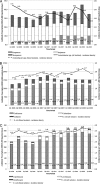Surveillance and correlation of antibiotic prescription and resistance of Gram-negative bacteria in Singaporean hospitals
- PMID: 20065055
- PMCID: PMC2826017
- DOI: 10.1128/AAC.01076-09
Surveillance and correlation of antibiotic prescription and resistance of Gram-negative bacteria in Singaporean hospitals
Abstract
A surveillance study was performed in four Singapore public hospitals from 2006 to 2008 to determine the correlation between antibiotic prescription and Gram-negative bacterial antimicrobial resistance. Targeted organisms included ceftriaxone- and ciprofloxacin-resistant Escherichia coli and Klebsiella pneumoniae, as well as imipenem-resistant Pseudomonas aeruginosa and Acinetobacter spp. Antibiotic prescription data were collated in the WHO anatomical therapeutic chemical (ATC)/defined daily dose (DDD) format, while antibiotic resistance was expressed as incidence density adjusted for total inpatient-days every quarter. Individual trends were determined by linear regression, while possible associations between antibiotic prescription and resistance were evaluated via cross-correlation analysis. Results over 3 years indicated significantly rising incidence densities of ceftriaxone- and ciprofloxacin-resistant E. coli and imipenem-resistant Acinetobacter spp. (blood isolates only). Antimicrobial-resistant Klebsiella pneumoniae rates declined. The prescription rates of piperacillin-tazobactam, ertapenem, meropenem, ciprofloxacin, and levofloxacin increased significantly, while imipenem and moxifloxacin prescription decreased. Cross-correlation analysis demonstrated possible associations between prescription of fluoroquinolones and ciprofloxacin-resistant E. coli (R(2) = 0.46), fluoroquinolones and ceftriaxone-resistant E. coli (R(2) = 0.47), and carbapenems and imipenem-resistant Acinetobacter spp. (R(2) = 0.48), all at zero time lag. Changes in meropenem prescription were associated with a similar trend in imipenem-resistant Acinetobacter blood isolates after a 3-month time lag. No correlation was found between cephalosporin use and resistance. In conclusion, our data demonstrated correlation between prescription of and Gram-negative bacterial resistance to several, but not all, key antimicrobial agents in Singapore hospitals. In areas where Gram-negative bacterial resistance is endemic and prescription of broad-spectrum antimicrobial agents is high, factors other than antimicrobial usage may be equally important in maintaining high resistance rates.
Figures


Similar articles
-
Relationships between antimicrobial use and antimicrobial resistance in Gram-negative bacteria causing nosocomial infections from 1991-2003 at a university hospital in Taiwan.Int J Antimicrob Agents. 2005 Dec;26(6):463-72. doi: 10.1016/j.ijantimicag.2005.08.016. Epub 2005 Nov 8. Int J Antimicrob Agents. 2005. PMID: 16280243 Free PMC article.
-
Evaluation of Ertapenem use with impact assessment on extended-spectrum beta-lactamases (ESBL) production and gram-negative resistance in Singapore General Hospital (SGH).BMC Infect Dis. 2013 Nov 6;13:523. doi: 10.1186/1471-2334-13-523. BMC Infect Dis. 2013. PMID: 24195651 Free PMC article.
-
Five-year surveillance and correlation of antibiotic consumption and resistance of Gram-negative bacteria at an intensive care unit in Serbia.J Chemother. 2020 Oct;32(6):294-303. doi: 10.1080/1120009X.2020.1755588. Epub 2020 Apr 23. J Chemother. 2020. PMID: 32321359
-
Sulopenem: An Intravenous and Oral Penem for the Treatment of Urinary Tract Infections Due to Multidrug-Resistant Bacteria.Drugs. 2022 Apr;82(5):533-557. doi: 10.1007/s40265-022-01688-1. Epub 2022 Mar 16. Drugs. 2022. PMID: 35294769 Review.
-
Literature review on the distribution characteristics and antimicrobial resistance of bacterial pathogens in neonatal sepsis.J Matern Fetal Neonatal Med. 2022 Mar;35(5):861-870. doi: 10.1080/14767058.2020.1732342. Epub 2020 Feb 26. J Matern Fetal Neonatal Med. 2022. PMID: 32102584 Review.
Cited by
-
Control of Helicobacter pylori with engineered probiotics secreting selective guided antimicrobial peptides.Microbiol Spectr. 2023 Sep 15;11(5):e0201423. doi: 10.1128/spectrum.02014-23. Online ahead of print. Microbiol Spectr. 2023. PMID: 37712669 Free PMC article.
-
Five-Year Antimicrobial Resistance Patterns of Urinary Escherichia coli at an Australian Tertiary Hospital: Time Series Analyses of Prevalence Data.PLoS One. 2016 Oct 6;11(10):e0164306. doi: 10.1371/journal.pone.0164306. eCollection 2016. PLoS One. 2016. PMID: 27711250 Free PMC article.
-
Systematic analysis of the relationship between antibiotic use and extended-spectrum beta-lactamase resistance in Enterobacteriaceae in a French hospital: a time series analysis.Eur J Clin Microbiol Infect Dis. 2015 Oct;34(10):1957-63. doi: 10.1007/s10096-015-2437-3. Epub 2015 Jul 24. Eur J Clin Microbiol Infect Dis. 2015. PMID: 26205663
-
Comparable outcomes for β-lactam/β-lactamase inhibitor combinations and carbapenems in definitive treatment of bloodstream infections caused by cefotaxime-resistant Escherichia coli or Klebsiella pneumoniae.Antimicrob Resist Infect Control. 2015 May 1;4:14. doi: 10.1186/s13756-015-0055-6. eCollection 2015. Antimicrob Resist Infect Control. 2015. PMID: 25932324 Free PMC article.
-
Carbapenem-Resistant Acinetobacter baumannii and Enterobacteriaceae in South and Southeast Asia.Clin Microbiol Rev. 2017 Jan;30(1):1-22. doi: 10.1128/CMR.masthead.30-1. Epub 2016 Oct 19. Clin Microbiol Rev. 2017. PMID: 27795305 Free PMC article. Review.
References
-
- Bartoloni, A., F. Bartalesi, A. Mantella, E. Dell'Amico, M. Roselli, M. Strohmeyer, H. G. Barahona, V. P. Barron, F. Paradisi, and G. M. Rossolini. 2004. High prevalence of acquired antimicrobial resistance unrelated to heavy antimicrobial consumption. J. Infect. Dis. 189:1291-1294. - PubMed
-
- Bergman, M., S. T. Nyberg, P. Huovinen, P. Paakkari, A. J. Hakanen, and the Finnish Study Group for Antimicrobial Resistance. 2009. Association between antimicrobial consumption and resistance in Escherichia coli. Antimicrob. Agents Chemother. 53:913-917. - PubMed
-
- Boucher, H. W., G. H. Talbot, J. S. Bradley, J. E. Edwards, D. Gilbert, L. B. Rice, M. Scheld, B. Spellberg, and J. Bartlett. 2009. Bad bugs need drugs: no ESKAPE! An update from the Infectious Diseases Society of America. Clin. Infect. Dis. 48:1-12. - PubMed
-
- Clinical and Laboratory Standards Institute. 2005. Performance standards for antimicrobial susceptibility testing. Supplement M100-S14, vol. 24, no. 1. Clinical and Laboratory Standards Institute, Wayne, PA.
-
- Clinical and Laboratory Standards Institute. 2006. Analysis and presentation of cumulative susceptibility test data; approved guideline, 2nd ed. Document M39-A2, vol. 25, no. 28. Clinical and Laboratory Standards Institute, Wayne, PA.
Publication types
MeSH terms
Substances
LinkOut - more resources
Full Text Sources
Medical
Research Materials
Miscellaneous

